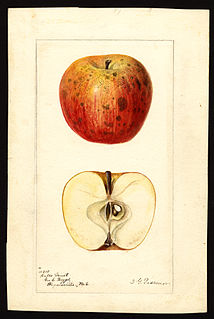
'Ralls Janet' is an apple cultivar that is also known by many other names. It has been used extensively in modern apple breeding, and has several commercially important offspring. It was grown at Monticello by Thomas Jefferson. It has been said that the name derives from Edmond-Charles Genet, a Frenchman who gave cuttings to Thomas Jefferson, who then passed them on to Virginia nurseryman M. Caleb Ralls, but this claim was not made until about 100 years after the apple became known and may not be accurate.

The Ben Davis is an apple cultivar.
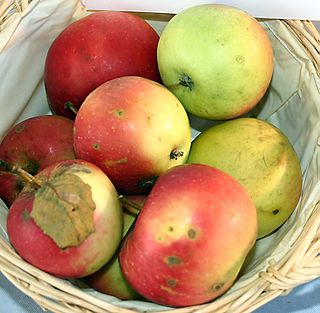
The Jonathan apple is a medium-sized sweet apple, with a touch of acid and a tough but smooth skin. It is closely related to the Esopus Spitzenburg apple, good for eating fresh and for cooking.
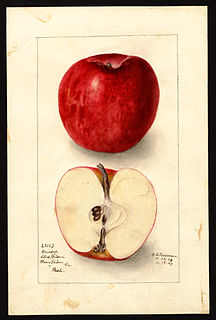
Winesap is an old apple cultivar of unknown origin, dating at least to American colonial times. Its apples are sweet with a tangy finish. They are used for eating, cooking, and cider.

Blenheim Orange is a cultivar of apple. It was found at Woodstock, Oxfordshire near Blenheim in England in about 1740. It has been described as a cooking apple.

Esopus Spitzenburg or Aesopus Spitzenburgh is a variety of apple. It was discovered early in the 18th century near Esopus, New York and is reputed to have been a favorite apple of Thomas Jefferson, who planted several of the trees at Monticello.

Bismarck is an apple cultivar. The fruit from the tree is used for cooking due to its sharp flavour and is most commonly pureed when cooking.

'Tompkins King' is a triploid cultivar of apple, also called 'King' or 'King of Tompkins County'. It was thought to have originated at Jacksonville in Tompkins County, New York, but Liberty Hyde Bailey investigated the tree there, and discovered that it was grafted. The cultivar was apparently brought from Warren County, New Jersey in 1804.

Yellow Bellflower is a cultivar of domesticated apple that originated in New Jersey. It has many other names including "Belle Flavoise" and "Lincoln Pippin". It is probably the best known of a group of apple cultivars referred to as the yellow bellflower group, with fruit that are generally elongated, with largely yellow skin. Along with the Yellow Bellflower, the Ortley is the oldest of the group.

Manks Codlin is an early cultivar selected from the domesticated apple that were growing at Isle of Man. It has many other names, including 'Winter Saint Lawrence' and 'Eva'. It first fruited in 1815. This cultivar is considered particularly cold hardy and well suited to exposed sites and poor soils.

'Duchess of Oldenburg' is an old Russian cultivar of cultivated apple which has attractive streaks of yellow and red. It was commonly but not universally known in America simply as 'Oldenburg' after the American Pomological Society listed that as the official name, a name also used for the 'Geheimrat Dr. Oldenburg' cultivar. The skin of the apple is more prominently striped than that of 'Geheimrat Dr. Oldenburg'.

Golden Russet is an old American cultivar of domesticated apple which is excellent for fresh eating as well as for apple cider production. It is a russet apple and is therefore especially used as a cider apple. It is sometimes known as 'English Golden Russet', and has frequently been confused with 'English Russet'.

Wolf River is an American cultivar of domesticated apple, which originates from the shores of the Wolf River of Wisconsin, in the United States of America, known since 1875. The tree is exceptionally frost hardy and generally disease resistant, and thus keeps well in storage. The fruit usually ripens mid-September to early October. It is large, commonly weighing over a pound, and fairly sweet with a distinctive red and yellow appearance. It has many culinary uses, as it keeps its shape well when cooked.

Liveland Raspberry or Lowland Raspberry is an old cultivar of domesticated apple, first recorded before 1870, that originated from the Livland Governorate of eastern Europe and was introduced into the United States of America in 1883. It is a very early ripening apple.

'Detroit Red' is a variable apple cultivar, possibly the same as 'Detroit Black', that gives fruit of mediocre quality, somewhat unreliably or biennially. It was grown at Monticello by Thomas Jefferson.
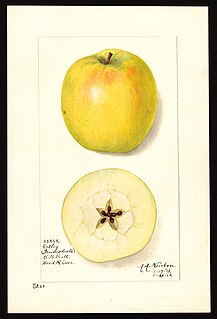
Ortley is a cultivar of domesticated apple that originated in New Jersey. It has many other names including "Cleopatra" and "Jersey Greening". The fruit is similar to the Yellow Bellflower.
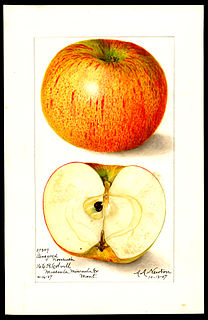
'Peasgood's Nonsuch' is an apple cultivar used both for eating fresh and for cooking. Several other apple cultivars are descended from it.
'Autumn Bough' is an early ripening cultivar of domesticated apple also known by various other names including 'Montgomery Sweet', 'Philadelphia Sweet', 'Sweet Bellflower', 'Sweet Harvest', and 'White Sugar'.

The 'Melon' apple, also called 'Watermelon' and 'Norton's Melon' is a partly red dessert apple in season from autumn through early winter. Its quality is excellent, but it does not keep well into late winter. It originated among seedling trees that were brought from Connecticut to make an orchard in New York state in 1800.

Hawthornden or Hawthorndean is an apple cultivar that is used for cooking. It is also known as Wheeler's Kernel, Lincolnshire Pippin, and Lord Kingston, and has been incorrectly known as Maiden's Blush and Hawley.



















